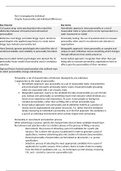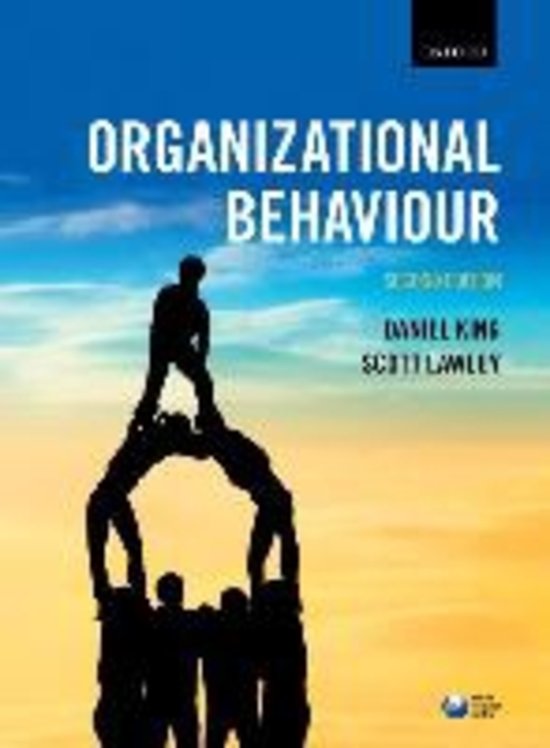Part 3 managing the individual
Chapter 8 personality and individual differences
Key theorist Key terms
Carl gustav jung: swiss psychoanalyst who noted the Nomothetic approach; views personality as a set of
distinction between introverted and extraverted measurable traits or types which can be represented on a
personalities static framework or model
Katherine cook briggs and isobel briggs myers; American Personality testing; the use of questionnaires to measure
psychologists who applied jungs theory to create myers- personality, often used in recruitment and selection in
briggs type indicator personality test organizations
Hans Eysenck; german psychologist who noted the role of Ideographic approach; views personality as complex and
emotional stability and instability in personality formation unique to each individual, and as something which changes
through influences from world around us
Raymond cattell; british psychologist who devised the 16 Social-radical approach; recognizes that rather than just
personality factor model of personality used in workplace being able to measure personality, organizations have an
selection effect upon the personalities of their members
Sigmund freud; Austrian psychoanalyst who outlined ways
in which personalities change and develop
Personality; a set of characteristics of behavior displayed by any individual.
3 approaches to the study of personality:
1. Nomothetic approach; sees personality as a set of measurable traits/ characteristics,
and sorts people into partic personality types/ scales; broad personality groupings
which are associated with a set of partic traits.
2. Ideographic approach; rejects as too simplistic the idea of personality as a set of traits
and, instead, sees personality as something much more dynamic which develops as a
result of our experience and interactions. As such, it sees people as having rich,
complex personalities, rather than as fitting into a certain personality type.
3. Social-radical approach; sees personality and its definition entirely as a product of
society and its organizational and power structures. F.e. rather than the workplace
simply measuring an individual’s personality, as in the first approach, the workplace is
a part of an individual environment which actively shapes their personality.
Personality in recruitment and selection process
When advertising a vacancy, specify the characteristics that an ideal candidate should have.
Recruitment and selection refers to 2 distinct phases of the process of filling a vacancy:
- Recruitment; the process of attracting a pool of candidates for a partic job.
Vacancy. This is where the vacancy is publicized in order to generate a pool of
applications, involves advertising jobs and creation of relevant documentation.
Desired personality characteristics are formalized as documents, s.a. person
specification
- Selection; process of selecting the most appropriate candidate from a pool of
applicants for a partic vacancy. This is where choice is made of who to employ
from the field of candidates and, s.a., inc techniques as interviewing, reviewing
CVs, and – central to concerns- personality tests
,Personality and recruitment
A further stage in the recruitment process where personality characteristics may be stated is
in the documentation that is sent to interested candidates (or available to download in some
instances). Such an application pack usually consists of 2 documents:
- Job description; a document which outlines the formal duties / activities that the
holder of a partic office will be expected to perform, and their place within the
overall org structure. It’s a description of exactly what tasks / duties would be
performed as part of the job
- Person specification; formal list of main requirements for a successful candidate
for a partic job. It’s a list of knowledge, skills, experience, qualifications, and
competencies that a successful candidate would be expected to hold. Might be a
split into essential characteristics (bare min that a candidate requires) and
desirable characteristics (those which might work in a person’s favor when making
a decision between candidates). Will also outline the ways in which different
characteristics will be assessed, that is to say the selection process that will be
used to match candidates to those characteristics.
Personality and selection
CV can be used to assess whether the relevant qualifications are held; references can be used
to check up on relevant experiences, and aptitude tests can measure specific skills s.a.
numeracy. But what about personality characteristics? How would a recruiter assess the
personality of a candidate to see that it matches that which is desired and measure their
enthusiasm / friendliness?
Personality tests and questionnaires are used in the selection process. It’s an efficient way of
getting a measure of the personality of a large number of candidates, but it comes at the
expense of the type of data that’s produced- rather than the rich knowledge of a personality
that we get from knowing somebody personally, it’s presented, instead, as an abstract set of
numbers and measurements.
Measurement of personality in selection process involves a trade-off between the time
available and richness of data about a candidates personality that can be gleaned.
This trade off relates to the nomothetic and ideographic approaches to personality.
- Nomothetic; suggest personalities can be represented as a set of standard
characteristics and can thus be measured efficiently using instruments s.a.
questionnaires.
- Ideographic; sees personalities as rich / complex. Representing personalities
though efficient means, s.a. tests, comes at expense of the richness of personality
data gaine- complexity and insight into an individ personality is lost.
Any one technique of recruitment and selection fares badly in its perspective validity, that is
to say how well it predicts performance in the job or gets an accurate picture of personality.
Yet given the costs and time associated with recruitment and selection, it’s important for org
to get it right, to fit the right person to the vacancy.
The more time available, the richer/ more complex the
info that can be gathered about a candidates personality
, the less time available more efficient methods might be
needed which give more blunt/ abstract info about a
candidates personality
nomothetic approaches to personality
someone’s personality can be summed up by one partic personality characteristic, also
known as trait. This is a characteristic of the person, often considered the behavior, thoughts,
and emotions that the person exhibits considered stable, over time.
We often describe someone’s personality as a set of traits/ adjectives which relate to that
person, f.e. friendly, nice etc.
Nomothetic; an approach which views personality as a set of measurable traits/ types
The traits are organized into a model/ frame work. 2 approached of personality for this
theory:
- Classify people into broad personality types; associated with each type is a set of
trait that people belonging to that type are likely to display
- some start from traits themselves, usually plotting people on a number of scales
between two opposite ends of a partic trait (f.e. between reserved and outgoing)
in both cases, the approach suggests that personality is measurable, using instruments s.a.
questionnaires. Personality types and scales are the frameworks on which an individuals
personality can be represented / categorized.
Theories of personality type
Theories of personality type bring together different traits in broad groupings, seeing the
traits as being representative characteristics of the broader personality types. The idea of the
types are used today in the workplace in myers – briggs type indicator (MBTI); a personality
testing instrument based on personality types of carl jung. However, the ide idea of
categorizing personalities into different types stretches back into antiquity.
Four humors; the 4 elements that Hippocrates suggested made up the human body and
which also divided into 4 personality types;
Humor Personality type Description
Blood sanguine Warm / outgoing; a person who thrives in social environments- lively, with few concerns
and cares in world
Phlegm Phlegmatic Cool/ rational- a controlled, thoughtful, and calm personality
Yellow bile Choleric Most volatile of the 4, impulsive, excitable, maybe touchy and bad tempered
Black bile Melancholic Reserved/ withdrawn- quiet/ socially the opposite to sanguine; an anxious
temperament, governed by worries, concerns, and even despondency
carl jung: introverts and extraverts
while this introduces the notion of personality types, it’s with the work of psychoanalyst jung
that we see the origins of the personality scales/type theories that are more commonly
applied in the contemporary workplace. His types outlines a distinction between:
- introversion; a tendency to focus/ gain energy more from within the self rather
than externally. More reserved person, possibly uncomfortable in social
situations, might seem unsociable and withdrawn.
, - extraversion; a tendency to focus/ gain energy externally rather than from within
the self. Someone social/ outgoing, able to work room and start up a
conversation with people, engaging in small talks.
There are 2 partic words in which we relate, and we may do so to different degrees;
- external; rational, day to day, everyday reality that goes on around us
- inner; our own thoughts, dreams, fantasies etc.
jungs theory of intro/extraversion is about the balance we maintain between these 2 worlds,
and partic from which of these we gain our energy.
- Extravert; thrives on action and being engaged with people- if inactive they can
feel restless. They get little energy from within, instead getting their energy from
others in a social situation
- Introvert; capable of, and thrives on, working alone, perhaps doing work that
needs consideration / contemplation rather than needing to be part of a crowd/
team. They get their energy from within- social situations drain them of that
energy
Cain: contemporary workplaces tend to favor the personality characteristics of an extravert
more, with working environments, s.a. open plan offices, and job adverts calling for team
players and upbeat personalities. Doesn’t mean that this personality is better! And some
workplaces miss the valuable ideas that are generated by more contemplative introverts.
It’s not a simple either or between the two: both are important/ complimentary aspects of
personality as opposed to mutually exclusive opposites. An individ may lean more to one of
both.
Jungs: there’s a complex relation between an individ position on the intro-extraversion scale
on the one hand, and 2 psychological functions on the other: how we perceive the world
( sensing / intuition) and how we make our judgements about the world (thinking / feeling).
These relations form the basis for the myers-briggs type indicator (personality profiling
instrument).
Mybers- briggs and the application of jung
They used junghs classification as base for their own classification of personality types (mbti)
The mbti uses a questionnaire to work out where an individ lies between a set of 4
personality indices;
- Extra/introversion (e/i); to which orientation are we more inclined when directing
our actions and energies; world around us for our inner selves
- Sensing/ intuition (s/i); how do we perceive / gather info about world around us?
- Thinking / feeling (t/f); once we have info, how to analyze / act upon it, using it to
make decisions/judgements
- Judgement/ perception (j/p); how do we deal with/ act upon, the world around
us? Plan in advance/ in moment?
Draw 8.2 in p269





